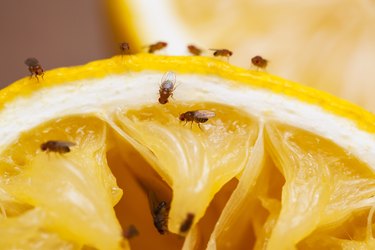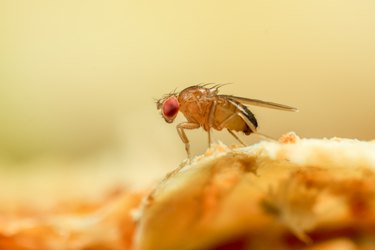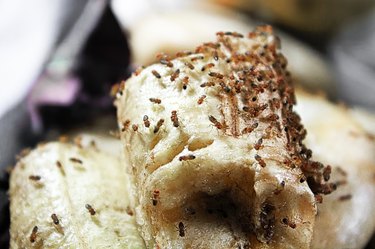
If you want to get rid of fruit flies, do you have to stop bringing fruit into the house? No, but unless you have plans to eat the fruit right away, it's best you skip it at the grocery store. Fruit flies breed on overripe and fermenting fruit, like those apples and bananas you've left for days on the kitchen counter. They will also hover around trash cans, inside the garbage disposal, or any other place you leave rotten fruit scraps, and if they can get close to those scraps, you'll have a fruit fly infestation on your hands in no time.
Fruit flies seemingly come out of nowhere, and that's due to the fact that they breed rapidly and prolifically, so it only takes a few — and a suitable supply of soft, rotting fruit — to create an infestation. They may get into your house on fruit they've already infected, but they can also get in through open windows and doors, especially in the late summer when the weather is still warm, and fruit is abundant. These pesky little critters don't spread disease as readily as mosquitoes and other pests, but they are known to spread salmonella, E. coli, and listeria, so they aren't harmless either.
Video of the Day
Video of the Day
It can be difficult to get rid of fruit flies, and the number-one control strategy is to keep your house clean. If you leave any fruity scraps around, including apples and bananas as well as veggies like tomatoes and squash, they'll find them whether they're on counters, in trash cans, or in the sink drain. (Fruit flies aren't also called drain flies for nothing). Apart from good sanitation, other methods used for fruit fly control include trapping and spraying them.
What Do Fruit Flies Look Like?

- Species name: Genus Drosophila (small fruit flies) and genus Trypetidae (large fruit flies).
- Physical characteristics: 2 to 4 millimeters in length on average with coloration ranging from pale yellow to dark brown to black with protruding brick-red eyes. Some species have black coloration on the wings.
- Wings or wingless? All adult fruit flies have wings and fly. Fruit fly larvae resemble worms and are often difficult to see because they can assume the coloration of the fruit on which they feed.

- Species varieties: Among the several species found in North America are the Mediterranean fruit fly (Ceratitis capitata), which attacks all citrus fruit except for lemons and limes; Rhagoletis pomonella, which in the larval stage is known as the apple maggot since the worms are often found burrowing in ripe apples; and the cherry fruit fly (R. cingulata), which causes extensive damage to fruit trees in the Northeastern United States. Other prevalent species are the Mexican fruit fly (Anastrepha ludens), which attacks citrus crops, and the Oriental fruit fly (Dacus dorsalis), which feeds on subtropical fruit.
- Life cycle and appearance: After hatching from eggs, fruit flies develop in three stages: larvae, pupae, and adult. Adult female fruit flies can each lay as many as 500 eggs in overripe or rotten fruit, and the wormlike larvae hatch in as little as 24 hours. The larvae, which are responsible for much of the damage done to fruit, live for eight days until they enter the pupal stage, from which they emerge as adults in six days. Adult fruit flies live for several weeks.
- How to tell apart from lookalikes: Fruit flies are often mistaken for fungus gnats, but they are easily distinguished. Fruit flies are larger, so much so that their protruding red eyes are clearly visible, and they more closely resemble houseflies, whereas gnats are closer in appearance to mosquitoes. Fruit flies are most often found on overripe fruit in the kitchen, while gnats are the pests you usually find in the soil in gardens or plant pots.
How to Get Rid of Fruit Flies
If you see fruit flies circling around a ripe apple or tomato, you can be sure the flesh of the fruit is full of larvae because adult females lay eggs in the flesh of ripe fruit, and it only takes a day for the eggs to hatch. Throwing out the infected piece will go a long way toward getting rid of the flies circling that particular piece of fruit, but other adults are still flying around looking for new places to lay eggs. Controlling them may call for several strategies, not just one.
Clean Up the House
Throwing out all ripe fruit that may be sitting on countertops and tables to deprive the flies of their breeding ground is the most obvious control measure, but don't stop there.
- Wipe down countertops with a disinfectant cleaner. Fruit flies hate cleanliness as much as a conscientious homeowner loves it. Don't forget backsplashes and other vertical surfaces close to food preparation areas.
- Empty all the trash cans and clean them with a disinfectant cleaner before putting in new trash bags.
- Disinfect the drains. If you have a garbage disposal, wipe the rim with a disinfectant cleaner and grind a few lemon peels. You might also pour a cup of chlorine bleach in the disposal while you're running it or better yet, pour in a commercial fruit fly and drain fly killer. You can also use fruit fly killer or bleach to disinfect other drains.
Set Fruit Fly Traps
Apple cider vinegar attracts fruit flies, and there is more than one way to use it to make a fruit fly trap. One way is to partially fill a bowl or glass, cover it tightly with plastic wrap, and secure the wrap to the vessel with an elastic band. Poke small holes in the plastic wrap with a fork or sharp knife. The flies will crawl through the holes to get the vinegar, but they won't be able to get out, and most will end up drowning in the liquid.
Another effective DIY trap calls for filling an open bowl about half to three-quarters full with apple cider vinegar and adding a few drops of dish soap. Fruit flies can normally land on liquids without drowning because there's enough surface tension to support their light bodies, but dish soap removes this advantage, and the flies that land will fall into the liquid and drown. Fruit flies are also attracted to fruit juice and even beer, so all you really need to do to make a homemade fruit fly trap is to leave a thin-neck bottle open with a small amount of juice or beer in the bottom. The flies will go into the bottle to get the liquid, but they won't be able to find their way out, and they'll eventually fall in and drown.
If you prefer, you can purchase commercial traps designed to catch fruit flies and similar pesky and tiny flying insects, such as gnats and mosquitoes. One such trap attracts the insects with ultraviolet light and catches them with sticky pads. You may prefer this type of trap if you're trying to control other insects as well as fruit flies. If you want to focus on fruit flies, try FlyPunch, a food-safe, granular bait that you leave in the container and deploy anywhere fruit flies are a nuisance. You can also use Bye Bye Fruit Fly, a similar product in liquid form that you pour into a bowl.
Try a Chemical Spray
A number of products are available online or at the grocery store that claim to target insect nervous systems without affecting people or pets. The problem with sprays is that they don't linger in the air, so they might kill the flies you see but not necessarily the ones that arrive on the scene after you've sprayed. If you decide that spraying is the way to go, you should expect to do it more than once.
Getting Rid of Fruit Flies Naturally
If you want to take an integrated pest management approach to pest control, you'll reserve the bug spray for use as a last resort. The first course of action in getting rid of fruit flies naturally is to eliminate food sources, and you accomplish that by cleaning up the house and throwing away all your old fruit or putting it in the refrigerator where the flies can't get to it. After you clean and disinfect countertops, drains and walls, deploying traps to catch stragglers is the next least environmentally intrusive control method. If all else fails, break out the spray.
How Fruit Flies Get in Your House
Fruit flies seem to come out of nowhere, but that's impossible. If you have an infestation, it's probably because you brought in some fruit from the grocery store that was already infected with larvae or pupae. It's also possible that the insects are breeding in another part of the house, possibly in an old mop or pile of rags in the laundry room. Fruit flies are attracted to old fruit because they feed on yeast produced during the fermenting process, and yeast grows in plenty of other places besides on fruit.
Keeping in mind that females lay hundreds if not thousands of eggs and that it only takes one day for eggs to hatch and a mere week for larvae to mature into adults, one infected peach can produce a lot of fruit flies. If the female responsible for your infestation didn't come into your house as a larva inside a peach, she could have flown in through an open window or even squeezed her way through a crack in the wall. The key to preventing her from being interested in your kitchen in the first place is to keep everything clean.
How to Prevent Fruit Flies
The measures you can take to prevent a fruit fly infestation include:
- Buy only the fruit you will eat. It doesn't take long for unused fruit to attract fruit flies.
- Wash your fruit well as soon as you get it home and store it in the refrigerator.
- Leave your outdoor lights off at night. They attract fruit flies.
- Put screens on your doors and windows.
- Wash all food containers before discarding them and take out the trash every day.
- Keep preserves, jams, and similarly fruity concoctions in sealed containers to prevent fruit flies from laying eggs in them.
Do Fruit Flies Spread Disease?
Because they are flies, fruit flies can land on a dirty surface and transfer microorganisms from those surfaces to clean ones. Fruit flies aren't associated with a particular disease, but this ability to transfer pathogens can lead to bacterial infections in humans. This is especially problematic if the flies are transported from tropical countries in infected fruit.
Fruit flies aren't attracted to plants. If you see bugs in the soil or near the roots, they are fungal gnats. Your plants aren't in any danger from fruit flies, although if you have indoor fruit trees, you should inspect the fruit carefully and avoid letting it get too ripe on the branch.
- Orkin: Fruit Fly Metamorphosis
- Country Living: How to Get Rid of Fruit Flies, Once and For All
- Britannica: Fruit Fly
- WebMD: How to Get Rid of Fruit Flies
- Plunkett's Pest Control: Where Do Fruit Flies Come From & How Do I Prevent Them?
- Sermo: Can Fruit Flies Make You Sick?
- InTechOpen: Introduction to Drosophila